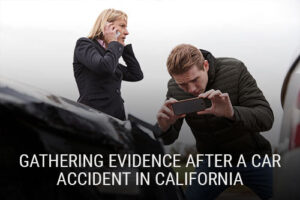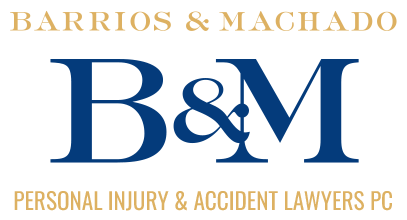
California's legal system allows accident victims to seek compensation even when they bear partial responsibility for a crash, thanks to the state's pure comparative negligence laws. However, the strength of your evidence directly impacts both your ability to prove the other party's fault and minimize your own liability percentage.
Why Evidence Matters in California Auto Accident Cases
Evidence serves as the foundation of your personal injury claim. In California's fault-based insurance system, the party responsible for causing the accident must compensate injured victims. Strong evidence helps establish liability, documents the extent of your injuries, and supports your demand for compensation.
In addition, evidence can help protect the amount of compensation you’re entitled to. California's pure comparative negligence system allows you to collect compensation even when you share fault for the collision, but that compensation will be reduced by your percentage of fault. This makes evidence-gathering even more critical, as reducing your percentage of fault directly increases your compensation.
Immediate Steps at the Accident Scene
Exchange Information (Required by California Law)
California Vehicle Code places legal obligations on drivers involved in accidents. According to California Vehicle Code Section 20003, drivers involved in injury accidents must:
- Provide their name and current address
- Share registration number and owner information
- Show their driver's license when requested
- Render reasonable assistance to injured persons
- Report the incident to police officers at the scene.
Vehicle Code Section 20008 requires drivers to file a written report within 24 hours if the accident resulted in injuries or death. Failing to meet these requirements can result in hit-and-run charges, regardless of who caused the accident.
Document the Scene of the Accident
Take Photos and Videos
- Vehicle damage from multiple angles
- The overall accident scene showing vehicle positions
- Street signs, traffic signals, and road conditions
- Skid marks, debris, and property damage
- Visible injuries (if appropriate)
- License plates of all vehicles involved.
Gather Detailed Information
- Full names and contact information of all drivers
- Insurance company names and policy numbers
- Vehicle make, model, year, and VINs
- Driver's license numbers
- Location of the accident, including street addresses and landmarks.
Document Environmental Factors
- Weather conditions
- Road surface conditions (wet, dry, construction, potholes, or the like)
- Lighting conditions
- Traffic control devices (such as stop signs, traffic lights, and yield signs)
- Date and time of the accident.
Collect Witness Information
Eyewitness testimony can provide crucial independent verification of how the accident occurred. Politely collect contact information from:
- Other drivers and passengers not involved in the car crash
- Pedestrians who saw the accident
- Residents or business owners in the area
- Passengers in your own vehicle.
Ask witnesses to provide a brief statement about what they observed. Many people are willing to help at the scene but may be difficult to locate later. Get their phone numbers, email addresses, and ask if they'd be willing to speak with your personal injury attorney if needed.
Medical Records and Healthcare Evidence
Get Medical Care Right Away
You might feel uninjured right after a crash, but adrenaline often hides pain and trauma. Some injuries, particularly soft tissue damage and concussions, may not show symptoms for hours or days. It’s wise to get a professional medical assessment of your condition rather than immediately claiming you’re okay.
While California typically gives injury victims two years to file personal injury claims, the discovery rule can extend this timeframe when injuries don't show up immediately after the accident.
Maintain Detailed Medical Records
These records establish a link between the accident and your injuries, document the severity of your condition, and provide evidence of your medical expenses:
- Emergency room records and ambulance reports
- All doctor visits related to the accident
- Diagnostic tests (X-rays, MRIs, CT scans)
- Physical therapy and rehabilitation records
- Prescription medications
- Medical bills and receipts.
Police Reports and Official Documentation
Understanding Police Report Limitations
Police officers who respond at the scene document their observations and may indicate contributing factors, but they don't determine legal fault. California Vehicle Code Section 20015 prohibits traffic officers from including fault determinations in property-damage accident reports, with some exceptions for determinations based on physical evidence.
However, a police crash report can be valuable evidence when you’re pursuing an accident insurance claim. The report may show details of the other party’s negligence, such as evidence of speeding or drunk-driving. If you’re filing a personal injury lawsuit, the report can also serve as a lead for your car accident lawyer to bolster your case. Thus, it’s wise to file a police report after an auto accident.
Obtaining Your Police Report
You can request a copy of the police report from the responding agency. The report typically includes:
- Basic accident details (time, location, weather)
- Vehicle and driver information
- Officer observations about the scene
- Citations issued
- Witness statements collected by police.
Preserving Electronic Evidence
Traffic Camera Footage
Many intersections and highways have traffic cameras that may have captured your accident. This footage is often automatically deleted after 30 to 90 days, so prompt action is essential. Contact:
- Local traffic departments
- State highway agencies (Caltrans for state highways)
- Private businesses with security cameras.
Vehicle Data Recorders
Modern vehicles often contain Event Data Recorders (EDRs) that capture information about speed, braking, and steering in the seconds before a car crash. This data can provide objective evidence about what happened, but it may be overwritten or become inaccessible over time.
Dash Cam Footage
Dashboard cameras are legal in California as long as they comply with regulations. For instance, your dashcam must not obstruct your driving view, and it must not record events in private properties. Generally, however, dashcam footage can be powerful evidence in vehicle accidents in public spaces. Such footage is also admissible in California courts, making it valuable in your personal injury case.
Mobile Phone Data
When distracted driving may be a factor, mobile phone data can reveal if a driver was using their device to text or make calls during the collision. However, obtaining these records typically requires legal action and court orders.
Social Media and Communication Precautions
What Not to Do
- Don't post about the accident or your injuries on social media.
- Avoid posting yourself doing physical activities when you are pursuing an injury claim.
- Avoid discussing details with anyone except your attorney and insurance company.
- Never admit fault or apologize at the scene.
- Don't accept quick settlement offers without legal consultation.
Protecting Your Privacy
Insurance companies and opposing attorneys often monitor social media accounts for information that could undermine your accident claim. Photos showing physical activity or statements about your condition can be taken out of context and used against you.
Dealing with Insurance Companies
After your accident, you’ll need to communicate with insurance companies, including your own insurance carrier. Your auto insurance policy likely requires that you notify them if you get involved in a crash, even if you weren’t at fault.
When you speak with any insurance company, provide only the basic facts but politely decline giving any other statements. Consult with an accident attorney first to avoid costly mistakes when dealing with insurers.
Document All Communications
- Keep records of all phone calls, including dates, times, and representatives you spoke with.
- Request written confirmation of important conversations.
- Save all correspondence and settlement offers.
- Take notes during conversations.
Understanding California's Insurance Requirements
California requires minimum liability coverage of $15,000 per person for bodily injury, but this amount is often insufficient for serious accidents. Fatal vehicle accidents in California result in nearly $6 billion in damages each year, highlighting the importance of thorough documentation to support higher damage claims.
Compelling Pieces of Evidence for Different Accident Types
Intersection Accidents
- Traffic signal records and timing
- Surveillance cameras from nearby businesses
- Witness testimony about signal colors
- Evidence of traffic law violations.
Highway Accidents
- Weather and traffic reports
- Construction zone information
- Commercial vehicle inspection records (for truck accidents)
- Caltrans incident reports.
Parking Lot Accidents
- Security camera footage
- Store incident reports
- Witness statements from customers and employees
- Evidence of parking lot design or maintenance issues.
Professional Evidence-Gathering
Accident Reconstruction Experts
Complex accidents may require professional reconstruction to determine how the crash occurred. These experts analyze:
- Vehicle damage patterns
- Skid marks and debris fields
- Impact forces and vehicle dynamics
- Road conditions and sight lines.
Medical Expert Testimony
Serious injury cases often require medical experts to explain:
- The relationship between the accident and your injuries
- The extent and permanence of your injuries
- Future medical needs and costs
- Impact on your ability to work and enjoy life.
California's Pure Comparative Negligence Law
Understanding California's comparative negligence law is crucial for evidence-gathering strategy. Under this system, your compensation is reduced by your percentage of fault. For example, if you’re awarded $100,000 in damages but are found to be 30% liable in the accident, you may receive only $70,000.
This means you’ll need evidence that minimizes your fault percentage while proving the other party's negligence. Focus on gathering essential evidence that shows:
- You were following traffic laws
- You were driving safely and attentively
- The other party violated traffic laws or drove negligently
- External factors (weather, road conditions) didn't contribute to your actions.
Time Limits and Legal Deadlines
California's Statute of Limitations
For most personal injury cases in California, the statute of limitations is two years from the date of the injury. However, several exceptions can extend or shorten this deadline:
- Discovery rule: The two-year clock may start when you discover an injury, not when the accident occurred.
- Government claims: You have only six months to file administrative claims against a government entity.
- Minors: The clock is paused until the injured person turns 18.
Evidence Preservation Urgency
While you have two years to file a lawsuit, evidence preservation must begin immediately. Critical evidence may disappear quickly:
- Security footage is often deleted within 30 to 90 days.
- Skid marks and debris are cleaned up within hours or days.
- Witness memories fade over time.
- Vehicle damage may be repaired or vehicles may be totaled.
Taking Action to Preserve Evidence After Your Accident
The moments and days following a car accident are crucial for your potential recovery. Keep in mind that while California gives you two years from the injury date to file personal injury lawsuits, protecting evidence must start right away. Don't let insurance companies take advantage of your unfamiliarity with the legal process or pressure you into quick settlements that don't reflect the true value of your claim.
Working With Barrios & Machado, Experienced Car Accident Lawyers
Our Experience and Excellence
At Barrios & Machado Personal Injury & Accident Lawyers, our founding attorneys Ursula Barrios and Guillermo Machado bring extensive experience to car accident cases.
- Attorney Ursula Barrios was admitted to practice in 2008 and immediately demonstrated exceptional legal skills, serving nearly 500 clients within her first year.
- Attorney Guillermo Machado was admitted in 2007 and has won millions of dollars for his personal injury clients, including many six- and seven-figure victories.
Since expanding into personal injury law in 2016, our law firm has successfully represented countless accident victims throughout Orange County, Los Angeles County, Riverside County, and Ventura County. We understand the complexities of California's comparative negligence laws and know how to gather and present evidence that maximizes our clients' recovery.
Our Approach to Evidence-Gathering
We act quickly to preserve critical evidence before it disappears. Our team:
- Immediately investigates accident scenes
- Secures surveillance footage, electronic evidence, and other types of evidence
- Works with expert accident reconstructionists
- Coordinates with medical experts to document injuries
- Handles all insurance company communications.
Bilingual Legal Services
We proudly offer bilingual legal services in both English and Spanish, ensuring all members of the Southern California community can access quality legal representation after a car accident.
Contact Barrios & Machado Today
If you've been injured in a car accident in California, don't face the insurance companies alone. The skilled legal team at Barrios & Machado Personal Injury & Accident Lawyers stands ready to safeguard your interests and pursue the full compensation you're entitled to.
Our proven track record of success and commitment to client care has made us a trusted name in personal injury law throughout Southern California. We handle all aspects of evidence-gathering and case preparation, allowing you to focus on your recovery while we build the strongest possible case on your behalf.
Call (714) 515-9696 for your free consultation today. Don't wait. Evidence disappears quickly, and your rights are too important to leave to chance.
Barrios & Machado Personal Injury & Accident Lawyers serves clients throughout Orange County, Los Angeles County, Riverside County, Ventura County and surrounding areas in Southern California. This article is for informational purposes only and does not constitute legal advice. Every case is unique, and outcomes depend on specific facts and circumstances.


